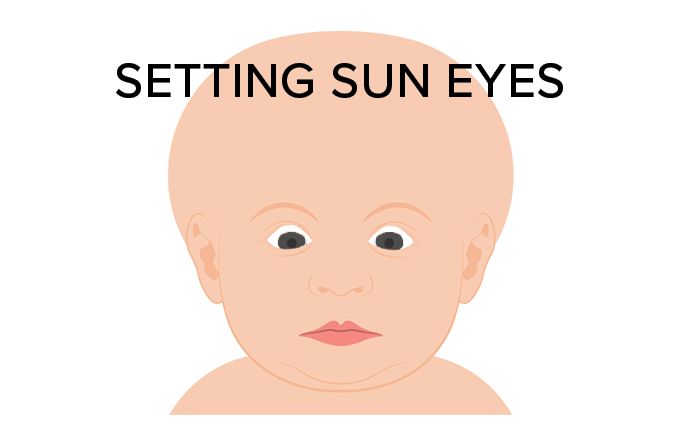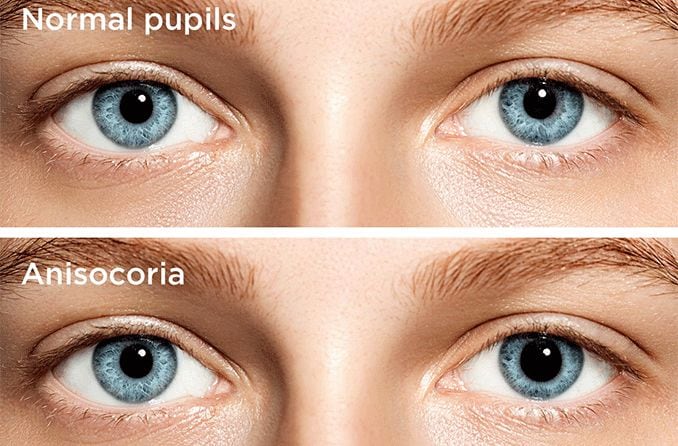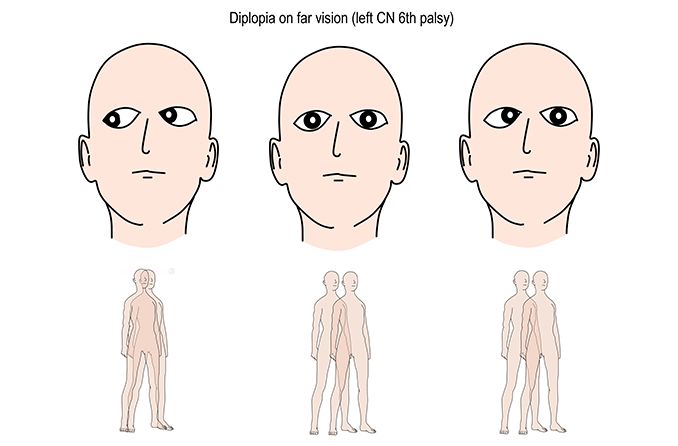Setting sun eyes, also called “sunset eyes” or “setting sun sign,” refers to a phenomenon in infants and young children in which the eyes are focused downward, and the upward gaze is inhibited.
There is a visible white space between the top portion of the sclera (white part of the eye) and the iris (colored part of the eye) in babies with setting sun eyes. Sometimes, the lower eyelid may also cover a portion of the pupil due to the eyes gazing downward.
The condition is often a sign of a neurological problem and should be evaluated as soon as possible.
What causes setting sun eyes?
Setting sun eyes are most often associated with neurological conditions that cause an increase in intracranial pressure and affect the part of the brain that controls eye movement. One such condition is hydrocephalus, a condition in which there is excessive fluid in the brain.
Babies who have hydrocephalus may also experience Parinaud syndrome, a condition that can restrict upward eye movement. Hydrocephalus can sometimes lead to Parinaud syndrome, and setting sun eyes can be present with both conditions.
In rare cases, setting sun eyes can also appear without any underlying health concerns. This is known as the “benign setting sun” phenomenon. Doctors believe the benign variety may be caused by underdeveloped ocular reflexes. Changes in light levels can trigger the downward gaze of a child who experiences benign setting sun eyes.
Benign setting sun eyes may resolve on their own by the time a child reaches 6 months of age. Children with sunset eyes due to hydrocephalus need brain surgery to relieve the pressure created in order for the eye problem to go away.
What are the signs of setting sun eyes?
The most prominent sign of setting sun eyes is its outward appearance. A child with setting sun eyes presents with a fixed downward gaze and an inability to look upwards. A large portion of the sclera (the white of the eye) is visible between the upper eyelid and the iris. The lower eyelid may also cover a portion of the pupil.
If a baby’s setting sun eyes are the result of infantile hydrocephalus, they may have other clinical signs that point to the underlying condition. Some of these symptoms may include:
- An unusually large head size
- Crossed eyes (strabismus)
- Reduced vision
- Shaky eyes (nystagmus)
Keep an eye out for these symptoms and be careful to observe whether your child’s downward gaze is constant or if it is triggered by changes in light levels. If it’s persistent, there’s a greater chance that it is associated with hydrocephalus.
SEE RELATED: Everything you need to know about your baby’s vision
Do sunset eyes only occur in infants?
No — older children can also have setting sun eyes associated with hydrocephalus. It’s actually one of the most significant indicators that hydrocephalus may be present.
An older child’s head would not appear enlarged the same way an infants would when hydrocephalus occurs, because the bones in the skull are already fused together at their older age. Once the bones have fused, they prevent the head from growing in size.
Since a larger head is one of the primary symptoms of hydrocephalus, doctors must look to other symptoms to identify the condition in older children. The setting sun eyes phenomenon is one of the key symptoms that they look for.
Other signs can include:
- Seizures
- Lethargy
- Uncontrollable vomiting
It is possible that setting sun eyes may not be related to hydrocephalus. Regardless, you should have your child examined if any of the above symptoms occur.
Note: Adults can also develop hydrocephalus, but sunset eyes doesn’t occur in older individuals.
Treatment for setting sun eyes
Treatment for setting sun eyes depends on the underlying condition. If setting sun eyes occurs on its own, it may also resolve on its own by the time a baby is 6 months old.
However, if setting sun eyes occurs with hydrocephalus, the hydrocephalus needs to be treated surgically. Treatment must be initiated promptly, or brain damage may occur.
Hydrocephalus can be treated with two different surgical procedures: shunt surgery or endoscopic third ventriculostomy (ETV).
Shunt surgery involves placing a tube (shunt) in the brain and connecting it to another tube that is placed under the skin. Together, these tubes help drain excess fluid from the brain to other parts of the body, such as the abdomen or chest cavity. If a shunt becomes defective, it needs to be replaced as soon as possible. Some people may require several shunt replacements over time.
Endoscopic third ventriculostomy (ETV) involves creating a small hole in the third ventricle of the brain (one of four fluid-filled cavities in the brain) so that the excess fluid can make its way out and relieve pressure.
These procedures may also be performed when the patient has Parinaud syndrome, as hydrocephalus is a major underlying cause of both Parinaud syndrome and setting sun eyes. Setting sun eyes and increased head circumference resolve following surgery.
Are setting sun eyes permanent?
In many cases, setting sun eyes go away when the underlying cause is treated properly. But there are some circumstances that may cause symptoms like setting sun eyes to return.
Sometimes, a shunt inserted during surgery for hydrocephalus can malfunction or cause an infection. If a shunt issue occurs, fluid can build up in the brain again and cause your child to experience the same symptoms they had before surgery (setting sun eyes, growing head size, etc.).
Monitor your child’s developing vision
Contact your eye doctor if you notice anything unusual about your child’s vision or eye movements — it’s the best way to ensure their vision develops properly into childhood and adulthood.
If your child has had a procedure that affects their vision, be sure to monitor any changes (positive or negative) and report them back to your doctor.










